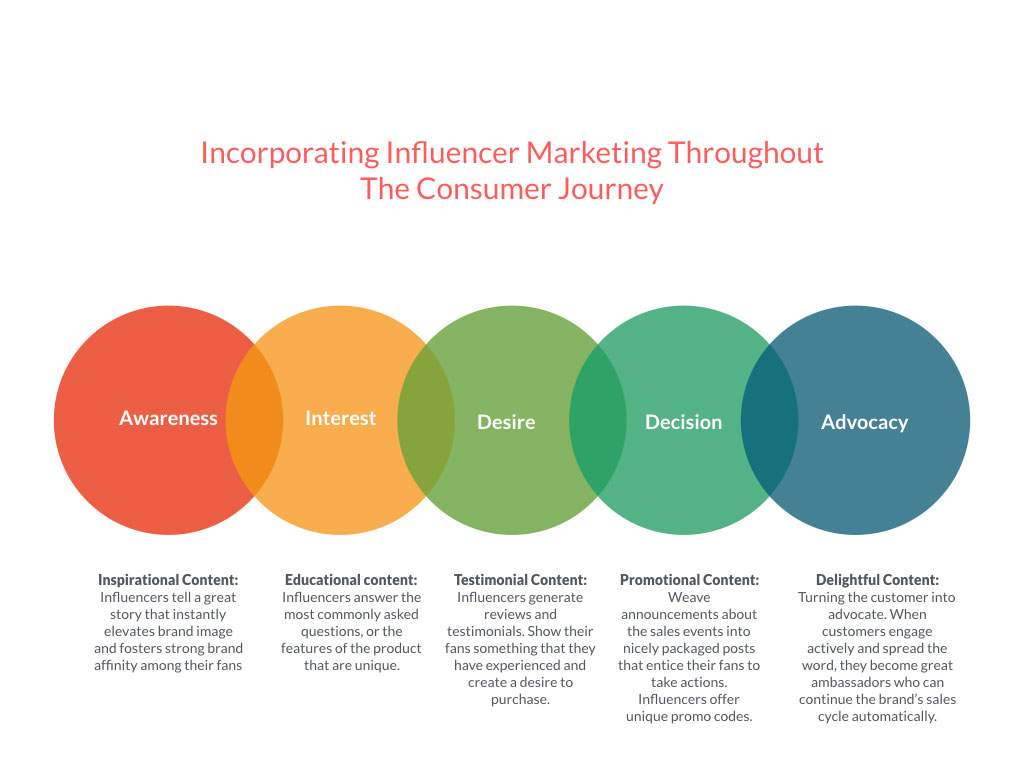5 INFLUENCER MARKETING TRENDS FOR 2018 THAT ALL MARKETERS SHOULD KNOW ABOUT
#1 Incorporating Integrated Influencer Marketing Throughout the Customer Journey
Influencers can be classified into 3 main categories: mega-Influencers, macro-Influencers and micro-Influencers.
If 2017 is the year of micro-Influencers, then 2018 is going to be a year of integration. There will be a growing demand to formulate integrated influencer marketing strategies which will weave together mega-Influencers, macro-Influencers and micro-Influencers as well as merge other well-established word-of-mouth strategies such as Loyalty, Advocacy and Referral Programmes. All of which will result in an integrated customer experience strategy.
Influencer marketing aims to build an experience and emotional connection between a brand and their target customers. This means building relevant content touch-points along the entire customer journey.
Depending on where on the journey a marketer may be focusing their efforts, different influencers, content channels and strategies can be employed.

Awareness
In order to generate awareness in the social media space, brands can work closely with macro-influencers and micro-influencers who are relevant to their business. At this stage, influencers create inspirational content through storytelling to introduce new products and feature capabilities to followers. This will instantly elevates brand’s image and fosters strong brand affinity among their fans.
Interest
At this stage, Influencers answer common questions about the product and services. Often times, it means taking the prospects through a series of interactions by providing interesting, educational and valuable content. However, creating good content is difficult. Determining the type of content that is appropriate for the business and taking into the consideration the unique proposition of each influencer the brands are working with isn’t easy either.
Desire
With heightened interests, businesses can start planning offers or promotions exclusively for the influencers’ followers or subscribers on social media. This is when brands can demonstrate that what they are selling will satisfy desired needs through reviews or testimonials etc. The right offer (with the right price), with proof confirming the quality of the product or service, will enhance their desire to purchase.
Action
At this stage, influencers direct customers to the correct paths and channels to complete their purchase or further evaluate options (measured in downloads, trials, demonstrations, inquiries, purchases, etc.) After the prospects transform into paying clients, it will prove the brand has used its social media channels successfully. One of the returns of investment (ROI) of social media marketing is converting leads into sales. But it is relatively challenging to measure how many people convert to customers through influencers. One of the most common method is to use ‘promo-codes’ and track the conversion brought about by each influencer.
Advocacy
Besides placing emphasis on Awareness, Interest, Desire, and Action, delighting a customer through the whole customer journey is the underlying factor which will turn a customer into a brand advocate. By leveraging on social media, this sales process can be extended to the point of turning the customer into an advocate for your product. When customers engage actively and spread the word, they become great ambassadors who can continue the brand’s sales cycle automatically.
The word-of-mouth that advocates spread is powerful. The more advocates one has developed; the sooner one can reduce the cost-per-user acquisition through influencer marketing.
#2 From Tactical Campaign To Always-on Strategy – Building Relationship With Influencers
A Return on Relationship is the value that is accrued by a person or brand due to nurturing a relationship over time. This will demonstrate that the influencer is true to the brand, and this true relationship connection will pass through to the consumer. ~ TED RUBIN, Chief Marketing Officer, Brand Innovators
By and large, influencer marketing has largely been leveraged on as a campaign tactic. To take influencer marketing from tactical to strategy level, it requires a comprehensive, always-on program built on an intrinsic, self-sustaining foundation of authentic brand-influencer relationships that consistently deliver value for both sides.
Customer journeys are ‘always on,’ while campaigns come and go. To fast track digital transformation, marketing strategists must learn more about how customers make decisions, who and what influences them, and why. Influencer relations, spanning from relationship building and nurturing, to the platforms that enable accurate identification and influencer management, help in fostering the relationship with influencers.
Engaging influencers that have already captured the attention of a target audience should also be an always-on strategy. Maintaining the relationship is complex and requires dynamic, personalised messaging based on who the influencer is, their preferences, and motivations.
Make influencer relations a priority now. If you continue to approach influencer marketing as usual, you are prepping to be left behind, losing control of your brand and the ability to compete in a world where customers are in control.
#3 Rapid Growth in the Influencer Marketing Technology and Solutions
Currently, with influencer marketing technology, there isn’t one solution that comprehensively covers all areas. From discovery to engagement to tracking and reporting, there are many different solutions, but they don’t always fit together. ~ Marketing technologist Travis Wright on MarTech
The maturity of influencer marketing and the rise of the micro-Influencers (an influencer with less than 100,000 followers) are the main underlying reasons for the growing Influencer Marketing solutions. Currently, hundreds of influencer marketing vendors provide somewhat similar but different influencer marketing solutions. These help in solving the following pain points:
Discover – Find influencers based on user criteria including all the engagement metrics, audience demographic and topics of influence. It is about finding the right fit between an influencer and a brand. A good fit between an influencer and brand is one where a mission, visions, messaging and identities align.
Connect – Communicate with influencers via the platform to discuss the engagement. Main feature focus on community management and direct messaging.
Engage (unpaid) – Engage influencer for an unpaid activity like writing a blog post and an Instagram post. This is quite common for product sampling.
Recruit (paid) – Engage influencer for a paid activity like speaking at an event or creating content, usually on sponsored content or pay per content creation model.
Review – Allow the advertising to review the content prior to promotion. This depends on whether a brand takes a hands-on or hands-off approach with their creative direction.
Measure – Advanced metrics and analytics for performance management to track the visitors, page views, click through rate and conversion rate. Analytics like these allow brands to understand the results of the influencers’ post, whether it be engagement, web traffic, earned media value or ROI.
#4 Influencers are the New Brands – Monetising through E-Commerce

Social media influencers are the new generation celebrities who have built incredible personal brands online and more and more influencers are trying to expand that influence into their own businesses.
For most influencers, getting started is difficult, as most of them don’t have the resources and expertise to build and manage their own multi-channel stores. E-commerce platforms like Amazon and Shopify are offering new services to help these influencers grow and scale in e-commerce.
Amazon Spark – Amazon Spark is like an Instagram feed and quite a number of influencers are already using the feature to post photos and highlight products from sponsoring brands.
Shopify VIP – Shopify VIP provides infrastructure and customer management support for e-commerce. Influencers will be able to launch their own multi-channel store, receive guidance from a dedicated personal concierge, and have access to applications, like embeddable buy buttons, which allow them to sell and cross-promote their own brands across various digital channels.
Superstar Influencers and China’s Internet Celebrities at The Heart of Alibaba Growth ~ Forbes
You can see that social media influencers are using e-commerce to turn their online fame into an online business, for example, @Zoella, @Michelle Phan, @Huda Kattan, @Emily Skype and @Michelle Lewin.
In China, social media influencers are better known as Wang Hong and Key Opinion Leaders (KOL). These top Wang Hong such as @Cherie, @BeautifulSummer, @Zowzow and @ZhangDaYi brought in millions of dollars in sales during the Taobao & TMall Online Shopping Festival 11.11.
#5 The Rise of B2B Influencer Marketing
Influence marketing isn’t new in B2B. In tandem with the trend set forth by their B2C brethren, B2B marketers will continue partnering with influencers but will focus more on B2B social channels like LinkedIn, Facebook, Twitter and YouTube, etc. Similar to B2C segment, the rise of micro-influencers in the B2B space and availability of more solutions to identify key B2B influencers such as Buzzsumo will help to propel the growth in B2B influencer marketing.
This case study on Entrepreneur highlights just some examples of the undeniable importance that B2B influencer marketing has. From blog and social media content to creating valuable video content for your consumers, if you can publish them on relevant influential websites, you’ll be able to generate quality leads and significantly boost your website traffic.
Most B2B influencers have built their industry status on work related credibility and their independent voice. Expecting B2B influencers to ‘sell’ immediately is a short-sighted strategy. The long term strategy is to build the relationship. Instead of asking for an explicit promotion or sales campaign, work with B2B influencers whose goals and ethos align with your business. To begin with, you can focus on small groups of B2B influencers and build deeper relationships with them so that you will get to know them and the influencers get to know you and your products more intimately.
Conclusion
This is just the beginning and influencer marketing will only continue to grow at the fastest speed in 2018.
So you better start planning a strategy and start building your influencer network!
What are you seeing as the biggest trends for influencer marketing next year?
Do you see the same social media marketing trends moving forward?
Please share your comments below.
